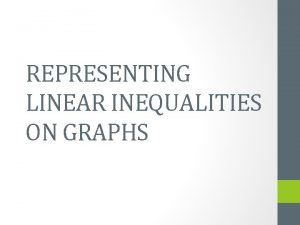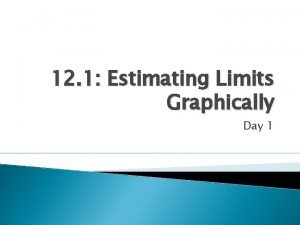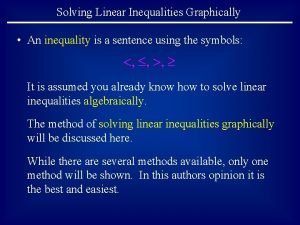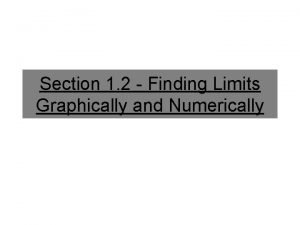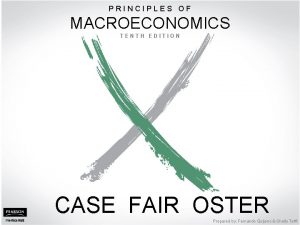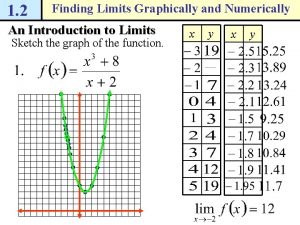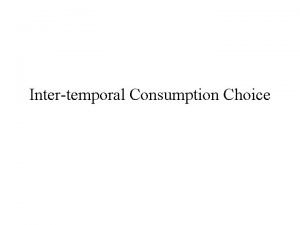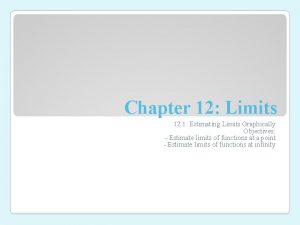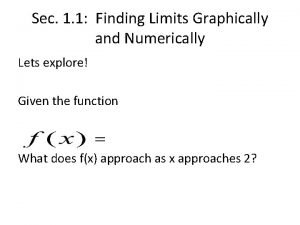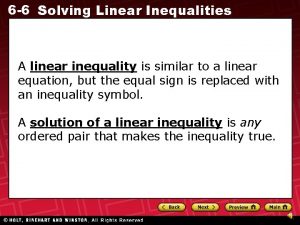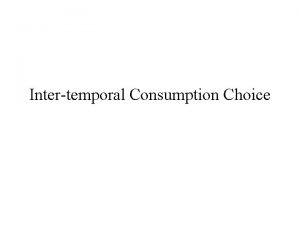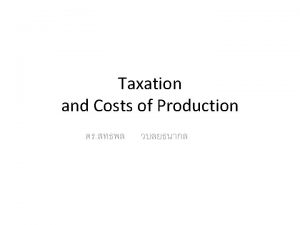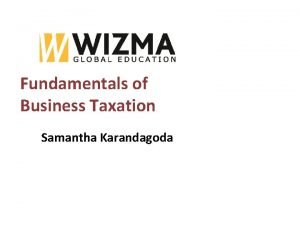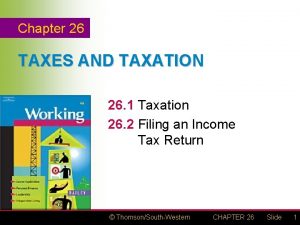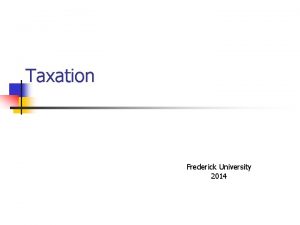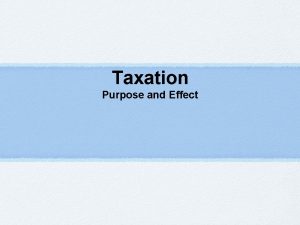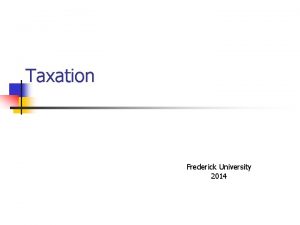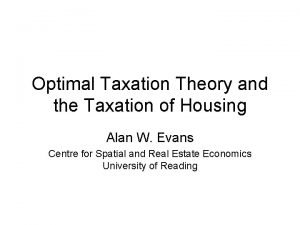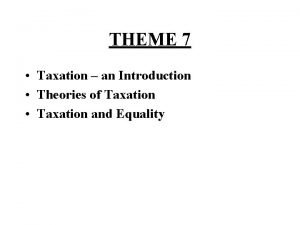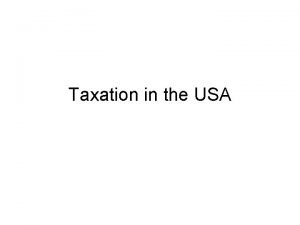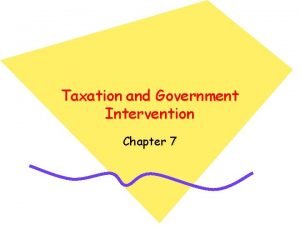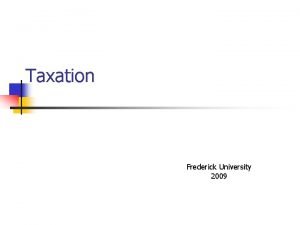Wrapping up taxation Today Studying taxation graphically The



































- Slides: 35

Wrapping up taxation Today: Studying taxation graphically The US Personal Income Tax The marriage penalty

Problem 1 a Megan’s share is 0. 8 – Q/20, 000 and Haley’s share is 0. 6 – Q/30, 000. 18, 000 OH Note that shares are on the vertical axis, and that the upward-sloping line has a vertical intercept of 0. 6 relative to OH. Full credit required that the intercepts were properly labeled. . 8 DH . 6 DM OM $ 16, 000

Problem 5 b n n Bjorn has just broken his hip and will require a trip to the hospital The total cost of being in the hospital is 20, 000 Q; his total benefit of being in the hospital is 100, 000 Q – 5, 000 Q 2 q How long will Bjorn want to stay in the hospital if he must pay a $60, 000 co-payment for his hospital stay? n Note that MB of 1 st day is higher than his co-payment Bjorn n n will decide to enter the hospital After the co-payment is made, Bjorn’s MC is zero Set Bjorn’s MC equal to his MB q 0 = 100, 000 – 10, 000 Q Q = 10

Problem 6 b n n n Assume that you work 40 hours per week, and that your hourly wage is $8 per hour U(H, E) = HE 4 Each unemployed person receives $100 per week in public health care; for the first $400 earned, $0. 25 in public health care is lost for each dollar earned q Thus, for anybody earning more than $400, no public health care funds are received.

Problem 6 b n For someone unemployed, only $100 in public health care is consumed; for the first 40 hours worked, the person earns $8 but loses $2 in public health care Net gain per hour worked is $6 q n Thus, working 40 hours leads to total consumption of $100 + $6 * 40 = $340. Then, solve the same way as in part (a), except use $340 instead of $320: E = $272, H = $68

Changes in consumption due to taxes n Recall that people typically consume less of a good or service once it is taxed q Example: Yacht tax in the early 1990 s n n n Tax on yachts over $100, 000 purchased in the US People bought yachts in other countries Net economic impact q q $16. 6 million in taxes collected (less than the $31 million predicted) Less income tax paid by workers (7, 600 jobs lost in the US)

Study of taxation graphically n n n Individual behavior Excess burden in a market with horizontal supply Taxes on labor Subsidies Pigouvian taxes

Pounds of corn per year How do taxes affect individual behavior? A Ca G E 2 Cb E 1 C 1 F B 0 i ii D B 1 Pounds of barley per year

Price per pound of barley Market excess burden, horizontal supply (1 + tb)Pb Pb Remember: Excess burden and deadweight loss mean the same thing a Tax revenues Excess burden of tax g f h d S’b i Sb Db q 2 q 1 Pounds of barley per year

Wage rate per hour Taxing labor Excess burden w f (1 – t)w g SL d i h a L 2 L 1 Hours per year

Price per unit of housing services Subsidies lead to excess burden, too Ph m Excess burden n (1 – s)Ph q o v r u Sh Sh ’ Dh h 1 h 2 Housing services per year

Recall: Pigouvian taxes reduce excess burden MSC = MPC + MD (MPC + cd) $ Pigouvian tax revenues i j MPC d c MD MB 0 Q* Q 1 Q per year

Recall double dividend hypothesis n Industry with negative externality q n n Pigouvian tax Reduces excess burden If tax proceeds are used to reduce other taxes, excess burden from these taxes are lowered Criticism: An environmental tax could lead to an increase in the excess burden in the labor market

An economist’s analysis n Given an amount of revenue that is generated, taxes should be imposed such that one of the following goals is achieved q q Excess burden is minimized Social welfare is maximized

The real world n n Taxes are often imposed that have the lowest amount of political resistance Excess burden seems less important than revenue generation q Sometimes efficiency is completely ignored

The US Personal Income Tax n n About 45% of federal revenues are generated through personal income taxes Federal taxes are easy and simple to understand, right?

Federal personal income tax liability

Digesting federal income tax liability Wages and compensation, Trade or business expenses, interest, dividends, capital gain moving expenses, educator (or loss), business income (or expenses, self-employed health loss), pensions, farm income (orinsurance premium payments, loss), rents, royalties, Social student loan payments, tuition Security benefits, etc. and fees, alimony paid, etc. Tax Base - “Above-the-line” Phase-out deductions Child tax, with additional income child tax, EITC, Adjusted Gross Income Six HOPE ordinary rates and Lifetime Learning, (10%, 15%, 25%, electric vehicles, health coverage - Exemptions 28%, 35%); mortgage interest, tax, 33%, adoption, differs by filing retirement savings contribution, - Larger of standard deduction or itemized deductions status; special child and dependent care credit, rates creditfor fordividends the elderly or the disabled, Start over to determine AMT Taxable Income and capital gainshomebuyer’s credit, D. C. First-Time tax liability using AMT base. etc. ; Phase-out with income Pay tentative AMT liability in • tax rate excess of regular tax liability Tax liability before credits - Tax credits Regular tax liability Pay tax or claim refund Charitable contributions, home mortgage interest, state and local taxes, medical expenses in excess of 7. 5% of AGI, casualty and theft losses, nonreimbursed employee expenses; Phase out with income; Differs by filing status

Other features of the US tax system n Exemptions q n $3, 300 per family member is 2006 Deductions q Standard deduction n q $5, 150 per single filer in 2006 $10, 300 per joint filer in 2006 Fixed amount, no documentation needed Itemized deductions n n Unreimbursed medical expenses above 7. 5% of AGI State and local income and property Taxes Certain interest expenses Charitable contributions

More on simplicity n The Tax Reform Act of 1986 (TRA 86) tried to simplify the tax system q Increased standard deduction n Fewer people needed to itemize deductions Personal exemption increased substantially Fewer people needed to file tax returns Since 1986 q q Tax laws became more complicated About 15, 000 changes to the tax code

More on simplicity n Is the tax code too complex? q Some support a flat income tax n n n q Same tax rate to everyone and each component of income No deductions Little room for personal exemptions and business expenses Criticism of flat income tax n Move tax burden from rich to middle class

Marginal tax rates Official Statutory Tax Rate Schedule (2006) Single Returns Joint Returns Taxable Income Marginal Tax Rate $0 -$7, 550 10% $0 -$15, 100 10% $7, 550 -$30, 650 15 $15, 100 -$61, 300 15 $30, 650 -$74, 200 25 $61, 300 -$123, 700 25 $74, 200 -$154, 800 28 $123, 700 -$188, 450 28 $154, 800 -$336, 550 33 $188, 450 -$336, 550 33 $336, 550 and over 35 Source: http: //www. irs. gov/formspubs/article/0, , id=150856, 00. html

Marginal tax rates Official Statutory Tax Rate Schedule (2007) Single Returns Joint Returns Taxable Income Marginal Tax Rate $0 -$7, 825 10% $0 -$15, 650 10% $7, 825 -$31, 850 15 $15, 650 -$63, 700 15 $31, 850 -$77, 100 25 $63, 700 -$128, 500 25 $77, 100 -$160, 850 28 $128, 500 -$195, 850 28 $160, 850 -$349, 700 33 $195, 850 -$349, 700 33 $349, 700 and over 35 Source: http: //www. irs. gov/formspubs/article/0, , id=164272, 00. html

Inflation issues n Notice that the ranges on the marginal tax rate tables increase from year to year q q About 3. 5 -4% from 2006 -2007 tax years Increases account for inflation n n Taxes are on real income, so to speak Alternative minimum tax (AMT) q q Not adjusted for inflation More Americans are subject to the AMT each year What used to be a policy on the rich, is now a policy on many upper-middle income Americans

The marriage penalty n n We examine the marriage issue further There are many reasons that people in the United States decide not to marry q q Costly to divorce if the marriage does not work out well Many low-income people may lose benefits n q People receiving public assistance may lose qualification for these programs if they marry someone who is working Tax burden may increase as a married couple than as if they lived together unmarried

Example of the marriage penalty: Taxes n Suppose a simple case q n Only taxable income determines taxes that have to be paid See what happens to tax burden when some couples get married

Recall marginal tax rates, 2007 Official Statutory Tax Rate Schedule (2007) Single Returns Joint Returns Taxable Income Marginal Tax Rate $0 -$7, 825 10% $0 -$15, 650 10% $7, 825 -$31, 850 15 $15, 650 -$63, 700 15 $31, 850 -$77, 100 25 $63, 700 -$128, 500 25 $77, 100 -$160, 850 28 $128, 500 -$195, 850 28 $160, 850 -$349, 700 33 $195, 850 -$349, 700 33 $349, 700 and over 35 Source: http: //www. irs. gov/formspubs/article/0, , id=164272, 00. html

Example 1, single n Cameron has $80, 000 in taxable income q Tax burden: $16, 510. 75 total n n n 10% of $7, 825 15% of $24, 025 25% of $45, 250 28% of $2, 900 Erin has $80, 000 in taxable income q Tax burden: $16, 510. 75 total n n 10% of $7, 825 15% of $24, 025 25% of $45, 250 28% of $2, 900 Official Statutory Tax Rate Schedule (2007) Single Returns Taxable Income Marginal Tax Rate Joint Returns Taxable Income Marginal Tax Rate $0 -$7, 825 10% $0 -$15, 650 10% $7, 825$31, 850 15 $15, 650$63, 700 15 $31, 850$77, 100 25 $63, 700$128, 500 25 $77, 100$160, 850 28 $128, 500$195, 850 28 $160, 850$349, 700 33 $195, 850$349, 700 33 $349, 700 and over 35 As single people, Cameron and Erin pay a total of $33, 021. 50 in taxes

Example 1, married n n Cameron and Erin get married Total taxable income is $160, 000 q Tax burden: $33, 792. 50 total n n n 10% of $15, 650 15% of $48, 050 25% of $64, 800 28% of $31, 500 $771 more than the total paid if they are single Official Statutory Tax Rate Schedule (2007) Single Returns Taxable Income Marginal Tax Rate Joint Returns Taxable Income Marginal Tax Rate $0 -$7, 825 10% $0 -$15, 650 10% $7, 825$31, 850 15 $15, 650$63, 700 15 $31, 850$77, 100 25 $63, 700$128, 500 25 $77, 100$160, 850 28 $128, 500$195, 850 28 $160, 850$349, 700 33 $195, 850$349, 700 33 $349, 700 and over 35

Example 2, single n Pat has $30, 000 in taxable income q Tax burden: $4, 108. 75 total n n n 10% of $7, 825 15% of $22, 175 Shannon has $200, 000 in taxable income q Tax burden: $52, 068. 25 total n n n 10% of $7, 825 15% of $24, 025 25% of $45, 250 28% of $83, 750 33% of $39, 150 Official Statutory Tax Rate Schedule (2007) Single Returns Taxable Income Marginal Tax Rate Joint Returns Taxable Income Marginal Tax Rate $0 -$7, 825 10% $0 -$15, 650 10% $7, 825$31, 850 15 $15, 650$63, 700 15 $31, 850$77, 100 25 $63, 700$128, 500 25 $77, 100$160, 850 28 $128, 500$195, 850 28 $160, 850$349, 700 33 $195, 850$349, 700 33 $349, 700 and over 35 As single people, Pat and Shannon pay a total of $56, 177 in taxes

Example 2, married n n Pat and Shannon get married Total taxable income is $230, 000 q Tax burden: $55, 100 total n n n 10% of $15, 650 15% of $48, 050 25% of $64, 800 28% of $67, 350 33% of $34, 150 $1, 077 less than the total paid if they are single Official Statutory Tax Rate Schedule (2007) Single Returns Taxable Income Marginal Tax Rate Joint Returns Taxable Income Marginal Tax Rate $0 -$7, 825 10% $0 -$15, 650 10% $7, 825$31, 850 15 $15, 650$63, 700 15 $31, 850$77, 100 25 $63, 700$128, 500 25 $77, 100$160, 850 28 $128, 500$195, 850 28 $160, 850$349, 700 33 $195, 850$349, 700 33 $349, 700 and over 35

Why the difference? n Look at marginal tax rates and the cut-offs

Example 1: Cameron/Erin, $80 K each Official Statutory Tax Rate Schedule (2007) Single Returns Joint Returns Taxable Income Marginal Tax Rate $0 -$7, 825 10% $0 -$15, 650 10% $7, 825 -$31, 850 15 $15, 650 -$63, 700 15 $31, 850 -$77, 100 25 $63, 700 -$128, 500 25 $77, 100 -$160, 850 28 $128, 500 -$195, 850 28 $160, 850 -$349, 700 33 $195, 850 -$349, 700 33 $349, 700 and over 35 More income is taxed in the 28% bracket after they get married

Example 2: Pat $30 K/Shannon $200 K Official Statutory Tax Rate Schedule (2007) Single Returns Joint Returns Taxable Income Marginal Tax Rate $0 -$7, 825 10% $0 -$15, 650 10% $7, 825 -$31, 850 15 $15, 650 -$63, 700 15 $31, 850 -$77, 100 25 $63, 700 -$128, 500 25 $77, 100 -$160, 850 28 $128, 500 -$195, 850 28 $160, 850 -$349, 700 33 $195, 850 -$349, 700 33 $349, 700 and over 35 As a married couple, less income is taxed in the 28% and 33% brackets; more in the 25% bracket

Two reasons that this happens Official Statutory Tax Rate Schedule (2007) n When there is one person that earns almost all of the income, more money is usually subject to the lower marginal rates q n Notice that the two lowest brackets vary by a factor of two At the higher brackets, the income ranges converge q Notice that the 35% bracket is the same whether or not you are married Single Returns Taxable Income Marginal Tax Rate Joint Returns Taxable Income Marginal Tax Rate $0 -$7, 825 10% $0 -$15, 650 10% $7, 825$31, 850 15 $15, 650$63, 700 15 $31, 850$77, 100 25 $63, 700$128, 500 25 $77, 100$160, 850 28 $128, 500$195, 850 28 $160, 850$349, 700 33 $195, 850$349, 700 33 $349, 700 and over 35
 Today's lesson or today lesson
Today's lesson or today lesson Today there is class
Today there is class Example of repitition
Example of repitition Today meeting or today's meeting
Today meeting or today's meeting Fingerprint ridge characteristics worksheet
Fingerprint ridge characteristics worksheet Today meeting or today's meeting
Today meeting or today's meeting A physical container or wrapping for a product
A physical container or wrapping for a product Surface area (with a wrapping task)
Surface area (with a wrapping task) Wrist hyperextension taping
Wrist hyperextension taping Warping in computer graphics
Warping in computer graphics Tensile strength
Tensile strength Ac joint taping leukotape
Ac joint taping leukotape Wrapping aorte ascendante
Wrapping aorte ascendante Packaging different products or services together
Packaging different products or services together Surface area of a ramp formula
Surface area of a ramp formula Neck wrapping for low-pressure hydrocephalus
Neck wrapping for low-pressure hydrocephalus Athletic training taping techniques
Athletic training taping techniques How to make a hot air balloon with tissue paper
How to make a hot air balloon with tissue paper Represent linear inequalities
Represent linear inequalities Estimating limits graphically
Estimating limits graphically How to solve an inequality graphically
How to solve an inequality graphically Finding limits graphically and numerically
Finding limits graphically and numerically Understanding limits graphically and numerically
Understanding limits graphically and numerically Limits graphically
Limits graphically Explain the law of demand and supply graphically
Explain the law of demand and supply graphically 12-1 estimating limits graphically
12-1 estimating limits graphically Sistem persamaan
Sistem persamaan What is the endowment point in economics
What is the endowment point in economics 12-1 estimating limits graphically
12-1 estimating limits graphically Solving linear programming problems graphically
Solving linear programming problems graphically Limits of composite functions
Limits of composite functions Graphically
Graphically Solving linear systems graphically assignment
Solving linear systems graphically assignment Example of linear inequality in two variables
Example of linear inequality in two variables Non linear simultaneous equations
Non linear simultaneous equations Fisher separation theorem graphically
Fisher separation theorem graphically


















